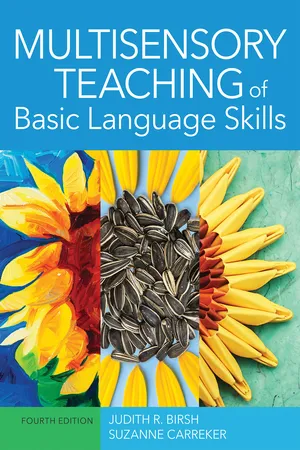
Multisensory Teaching of Basic Language Skills
- 920 pages
- English
- ePUB (mobile friendly)
- Available on iOS & Android
Multisensory Teaching of Basic Language Skills
About this book
Keep up with the latest on the highly respected multisensory teaching approach to literacy with this new fourth edition, a complete update of the bestselling textbook adopted in colleges and universities across the country. The most comprehensive text available on multisensory teaching, this book prepares today's educators to use specific evidence-based approaches that improve struggling students' language skills and academic outcomes in elementary through high school.
Educators will get rich background information on the systems and structures of the English language, plus a deep dive into the what and how of Structured Literacy Instruction. They'll also find practical strategies and guidelines on all aspects of language and literacy instruction, including planning effective lessons, connecting research with practice, conducting and interpreting assessment, understanding the emotional side of learning disabilities, and more. An essential reference and professional development resource to keep and use for years to come, this book gets educators ready to be thoughtful, skilled, and compassionate teachers of reading and language arts.
WHAT'S NEW:
- New chapters on pre-kindergarten literacy, executive function, and math learning disabilities
- Content now aligns with the 2018 IDA Knowledge and Practice Standards for Teachers of Reading and prepares students for the IDA certification exam
- Updated with the latest research in the field
- New insights and guidance on technology woven throughout the book
- Online companion materials and resources for many chapters
- More student-friendly features (see below)
SELECTED TOPICS COVERED: structured literacy instruction * oral language development * pre-k literacy * alphabet knowledge * phonemic awareness * decoding * spelling * handwriting * fluency * vocabulary instruction * reading comprehension * composition * assessment * executive function * math learning disabilities * effective learning environments * lesson planning * instruction for English language learners * instruction for older students and high-functioning adults
STUDENT-FRIENDLY FEATURES: Chapters now include learning objectives, an end-of-chapter Knowledge and Skill Assessment, reflection questions interspersed throughout, and new vignettes and case studies. The online companion materials feature sample lesson plans, answer keys, and other resources for further reading and reference.
Listed by the National Council on Teacher Quality's 2020 Teacher Prep Review as one of 10 textbooks that comprehensively and rigorously cover the scientific basis and instructional elements of the five essential components of effective reading instruction!
Explore the companion activity book!
Frequently asked questions
- Essential is ideal for learners and professionals who enjoy exploring a wide range of subjects. Access the Essential Library with 800,000+ trusted titles and best-sellers across business, personal growth, and the humanities. Includes unlimited reading time and Standard Read Aloud voice.
- Complete: Perfect for advanced learners and researchers needing full, unrestricted access. Unlock 1.4M+ books across hundreds of subjects, including academic and specialized titles. The Complete Plan also includes advanced features like Premium Read Aloud and Research Assistant.
Please note we cannot support devices running on iOS 13 and Android 7 or earlier. Learn more about using the app.
Information
Table of contents
- Cover
- Title Page
- Copyright
- Contents
- About the Online Companion Materials
- Online Companion Materials
- About the Editors
- About the Contributors
- Foreword
- Preface
- Acknowledgments
- Section I: Introduction to Multisensory Teaching
- Chapter 1. Connecting Research and Practice
- Chapter 2. Structured Literacy Instruction
- Section II: Pre-reading/Literacy Skills
- Chapter 3. Oral Language Development and Its Relationship to Literacy
- Chapter 4. Pre-Kindergarten Literacy
- Chapter 5. Alphabet Knowledge: Letter Recognition, Letter Naming, and Letter Sequencing
- Chapter 6. Teaching Phonemic Awareness
- Section III: Beginning Reading/Literacy Skills
- Chapter 7. Assessment of Reading Skills: A Review of Select Key Ideas and Best Practices
- Chapter 8. The Role of Executive Function in Literacy Instruction
- Chapter 9. Teaching Reading: Accurate Decoding
- Chapter 10. Teaching Spelling
- Chapter 11. Multi-Modal Handwriting Instruction for Pencil and Technology Tools
- Chapter 12. Fluency in Learning to Read: Conceptions, Misconceptions, Learning Disabilities, and Instructional Moves
- Chapter 13. Math Learning Disabilities
- Section IV: Advanced Reading/Literacy Skills
- Chapter 14. The History and Structure of Written English
- Chapter 15. Working With Word Meaning: Vocabulary Instruction
- Chapter 16. Strategies to Improve Reading Comprehension in the Multisensory Classroom
- Chapter 17. Composition: Evidence-Based Instruction
- Chapter 18. Designing the Learning Environment and Planning Multisensory Structured Literacy Lessons
- Section V: Instructional Strategies for Specific Populations and Skill Areas
- Chapter 19. Language and Literacy Development Among English Language Learners
- Chapter 20. Instruction for Older Students With a Word-Level Reading Disability
- Chapter 21. Working With High-Functioning Adults With Dyslexia and Other Academic Challenges
- Glossary
- Index